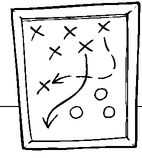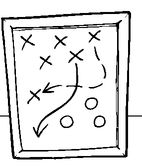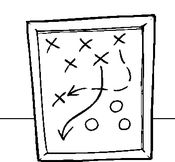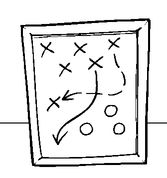
Chapter 5
Starting the Search
In This Chapter
➤ Making the job analysis
➤ Writing the job description
➤ What an applicant needs to fill the job
➤ Your current staff—a primary source
➤ Creating a job bank
➤ Encouraging referrals
In this chapter you will learn several ways to analyze jobs and write job descriptions that truly depict what that job really entails from day to day, week to week, year to year. You also will learn how to determine the education, experience, and personal traits candidates should bring to the job to perform the duties effectively. We’ll also examine how to use your present employees as a source for filling open positions.
A Job Is Open
Jobs can develop for a variety of reasons. What is needed to fill that job depends to a great extent on why the vacancy exists. The process differs significantly depending on whether you are replacing a worker who has left, or expanding the team or department.

Tactical Tips
Be just as thorough in making a job analysis whether the opening is a replacement for somebody who left or it’s an entirely new job.
When Refilling a Position
One of your employees notifies you she is leaving. If you work for a medium- or large-sized organization, you probably will notify human resources and request a replacement. In some companies you will notify your boss and start the process to find a new employee.
When It’s a Brand-New Position
Your team is overworked. You need a larger staff. You succeed in persuading your manager to add one or more positions to your team. What kind of jobs will you add?
In some teams all members do the same kind of work. For instance, in a data entry team, all members usually enter the same kind of data; in a quality control team, all members might perform the same analysis functions. In these cases you can just review the job descriptions to ensure that they are current.
What Does This Job Entail?
The way you obtain information about what a job entails is called job analysis. In some companies specialists perform these analyses. These specialists might be industrial engineers, systems analysts, or members of your human resources staff. If your company employs these people, use them as a resource. However, the best people to make an analysis are those closest to a job—you and other members of your staff. The following sections will discuss several ways to develop information for a job description. It is very helpful to design a worksheet to use in making the job analysis. A well-structured form will assure that all the bases are covered and result in a thorough analysis. A sample worksheet is shown later in this chapter.

Tactical Tips
A good job description is not a rigid depiction of functions. It should allow for reasonable deviations, additions, and variations.
Observing the Action
For jobs that are primarily physical in nature, watching a person perform the job will give you most of the material you need to write the description. If several people are engaged in the same type of work, observe more than one performer. Conversely, in jobs that are not primarily manual there is little you can learn from observation alone. For example, just watching someone sitting at a computer terminal isn’t enough to learn what’s being done.
Also, even a good observer might not understand what he or she is observing. Sometimes the job involves much more than meets the eye. Additional steps must be taken to get the full picture. Supplement your observations with discussions of what is being done with both the workers performing the jobs and their supervisors. Suggestions on how to do this will be given later in this chapter.
Interviewing the Worker
Ask the people who perform a job to describe the activities they perform. This technique makes clearer what you’re observing. Of course, you must know enough about the work to understand what’s being said and be able to ask appropriate questions.
It’s a good idea to prepare a series of open-ended questions in advance. Ask only questions that are specific to the job being analyzed. Avoid questions that can be answered in a single word, such as “yes.” Such questions yield very little information.
Questions such as the following will elicit good information:

Personnel Perils
When several people perform the same type of job, don’t select the most or least experienced or skilled workers to observe. Highly experienced workers often tailor the job to their own style and newcomers haven’t mastered the work. Studying a few mid-level performers will give you a more realistic concept of what that job actually entails.
➤ Tell me about how you spend a typical day.
➤ Tell me about some of the other work you occasionally do—how often and when do you do this work?
➤ What positions do you supervise (if any) and how much of your time is spent in supervising others?
➤ What responsibilities do you have for financial matters such as budgeting, purchasing, authorizing expenditures, and similar decisions?
➤ What equipment do you operate?
➤ What performance standards are you expected to meet on this job?
➤ What education and experience did you have prior to taking this job that prepared you for it?
➤ What training did you get on this job to help you do it effectively?
The answers to these questions should give you considerable insight into the job. But, to assure that you have the entire picture, it’s a good idea to also interview the person who supervises or leads the team.
Interviewing the Supervisor or Team Leader
If you’re analyzing a job other than those you supervise, speak to the team leader or supervisor of that group to obtain that person’s perspective of the position. The questions you ask the supervisor or team leader should be similar to those you asked the worker. Note variations in their answers. Probe to determine which is the more accurate description.
If you are evaluating a job that you personally supervise, try to take an objective view of the position and review it as if you were a stranger. Review in your mind how you view the position, what you believe the performer should be doing, and the standards that are acceptable. It’s not easy to do, but you’ll be amazed at the results. You’ll see things you never noticed before and interpret aspects of duties and processes in a different light. Companies have found that when the performance standards are developed collaboratively by managers and the people who perform the work, they are more realistic and more likely to be accepted and achieved.

Meanings and Gleanings
The major aspects of a job that must be accomplished by the employee are referred to as key results areas.
Indicate Performance Expectations
Some companies prefer to call the job description a “position results description” or a “job results description.” In this approach the true objective of this document is to determine what is expected of the people performing the job. Each description should include the major goal (why the job exists), the key results areas or KRAs (the main objectives of the job), and the standards for which performance will be measured.
By indicating performance standards and expected results, managers and employees can measure performance and use the results as motivation toward desired goals. Tailor the form you use to the type of job you’re analyzing. The following job description worksheet is a helpful tool:
Job title: ________________________________________________________________________
Reports to: _____________________________________________________________________
Duties performed: _______________________________________________________________
Equipment used: ________________________________________________________________
Skills used: _____________________________________________________________________
Leadership responsibility: ________________________________________________________
Responsibility for equipment: ____________________________________________________
Responsibility for money: ________________________________________________________
Other aspects of job: _____________________________________________________________
Special working conditions: ______________________________________________________
Performance standards: __________________________________________________________
Analysis made by: _______________________________________________________________
Date: ___________________________________________________________________________
What You Seek in a Candidate
After you know just what a job entails, you can determine the job qualifications and personal qualities you seek in the successful candidate. In some situations the job specifications must be rigidly followed. For example, in civil service jobs or in cases in which job specs are part of a union contract, even a slight variation from job specs can have legal implications.
In some technical jobs, a specific degree or certification might be mandated by company standards or to meet professional requirements. For example, an accountant making formal audits must be a certified public account (CPA); an engineer who approves structural plans must be licensed as a professional engineer (PE).
Other job specs might allow for some flexibility. If there’s no compelling reason for the candidate to have a specific qualification, you might deviate from the specs and accept an equivalent background. For example, one job spec may be completing a course in computer technology. If the candidate never took the course, but has excellent experience in that technology, you should have the flexibility to hire that person, if so desired.
Components of a Job Spec
The objective of the job specification is to provide a list of the aspects of a candidate’s qualifications that will enable him or her to perform the job satisfactorily. The usual components of the job specs are …
➤ Education Does a job call for college? Advanced education? Schooling in a special skill?
➤ Skills Must the candidate be skilled in computers? Machinery? Drafting? Statistics? Technical work? Any other skills necessary to perform a job?
➤ Work experience What should be the type and duration of previous experience in related job functions?
➤ Physical strength or stamina Does the job require heavy lifting or hard physical labor? If so, is it a significant part of the job or does it occur only occasionally? 

Tactical Tips
To ensure that the person you hire can do a job, the job specs should emphasize what you expect the applicant to have accomplished in previous jobs—not just the length of his or her experience.
➤ Intelligence Some jobs call for a high level of intelligence. Decisions must be made that require deep thinking, complex problem solving, or ability to think on one’s feet.
➤ Communication skills The job specs should indicate exactly which communication skills you need; for example, one-to-one communication, the ability to speak to large groups, innovative telephone sales methods, or creative writing skills.
➤ Accuracy of work If a job calls for “attention to detail,” specify what type of detail work. In some jobs there is no margin for error. Work must be done right the first time or serious problems might result; for example, working on a nuclear reactor or piloting a jet plane.
➤ Dealing with stress If a job calls for “ability to work under pressure,” indicate what type of pressure; for example, daily deadlines, occasional deadlines, round-the-clock sessions, difficult working conditions, or a demanding boss.
➤ Special factors Many other requirements might factor into the job specification such as fluency in a foreign language, willingness to travel, willingness to work weekends, willingness to work overtime on short notice, and anything else with which an employee must comply to perform the job satisfactorily.
Eliminating Good Prospects for the Wrong Reason
One of the most common problems in determining the specifications for a job is requiring a higher qualification level than really is necessary. This can knock out potentially good candidates for the wrong reason. The following identifies some of the areas in which this can occur:
➤ Education Suppose certain job specs call for a college degree. Is that degree necessary? Often it is, but just as often the degree has no bearing on a person’s ability to succeed in a job. Requiring a higher level of education sometimes has more disadvantages than advantages. You might attract smart and creative people; but the job might not challenge them, resulting in low productivity and high turnover. More important, you might turn away the best possible candidates for a position by putting the emphasis on a less important aspect of the job.
➤ Duration of experience Your job specs might call for 10 years of experience in accounting. Why specify 10 years? No direct correlation exists between the number of years a person has worked in a field and that person’s competence. Lots of people have 10 years on a job but only one year of experience (after they’ve mastered the basics of the job, they plod along, never growing or learning from their experience). Other people acquire a great deal of skill in a much shorter period. Rather than requiring a number of years, set up a list of skills a new employee should bring to a job, specifying how qualified the person should be in each skill. By asking an applicant specific questions about each of these factors, you can determine what he or she knows and has accomplished in each area.
➤ Type of experience Job specs often mandate that an applicant should have experience in “our industry.” Sure, there are some jobs in which the necessary skills and job knowledge can be acquired only in companies that do similar work. However, in many jobs a background in other industries is just as valuable. A different background might even be better because the new associate isn’t tradition-bound and will bring innovative concepts to the job.

Personnel Perils
Don’t clone your current team. It’s best to get people with diversified backgrounds who can augment the work of others on the team. When you set up specs for a job, ask yourself, “What must the applicant be able to do that other team members cannot do. Your team will be stronger if it includes people with different but complementary skills.
Internal Transfers and Promotions
When a change of job involves a promotion, most people are delighted and welcome the opportunity. However, not every transfer is a promotion. Often it’s a transfer—an opportunity for someone to learn, gain experience, and take a step toward preparing for career advancement. Most companies use a judicious mixture, combining internal promotion and transfers with outside recruitment to get and keep the best candidates for their openings.
Seeking to fill a vacancy from within a company has many advantages:
➤ People who already work in your company know the “lay of the land.” They’re familiar with your company’s rules and regulations, customs and culture, and practices and idiosyncrasies. Hiring these people rather than someone from outside your company saves time in orientation and minimizes the risks of dissatisfaction with your company.
➤ You know more about these people than you can possibly learn about outsiders. You might have worked directly with a certain person or observed him or her in action. You can get detailed and honest information about a candidate from previous supervisors and company records.
➤ Offering opportunities to current employees boosts morale within the company and serves as an incentive for all employees to perform at their highest levels.
➤ An important side effect is that it creates a positive image of your company in the industry and in your community. This image encourages good people to apply when jobs for outsiders do become available.
Although the advantages of internal promotion usually outweigh the downsides, there are disadvantages to consider:
➤ The job might require skills not found in your company.
➤ If you promote only from within, you limit the resources from which to draw candidates and might be restricted to promoting a person significantly less qualified than someone from outside your company.
➤ People who have worked in other companies bring with them new and different ideas and know-how that can benefit your team.
➤ Outsiders look at your activities with a fresh view untainted by overfamiliarity.
One of the major problems in interdepartmental transfers is the reluctance of department heads to release efficient and productive workers to other departments. It’s not easy to overcome this. A company implementing internal recruitment should notify all management that it will overrule any attempts to keep people who could be more valuable if transferred.
It also should be mentioned that people who are passed over for better positions in other departments are unlikely to remain with the company. These employees probably will seek jobs elsewhere. Unfortunately, both the department and the company could lose valuable employees.
Finding the Right Candidate from Within the Company
Many organizations have developed training programs that provide them with a steady stream of trained people for their expanding job needs. In some companies there’s a plethora of talent to choose from. However, there are times when there are no obvious candidates for a vacant job. You might have people in the company who are qualified to do the job—but you don’t know it. What can you do?
Search the Personnel Files
If properly maintained, personnel records can be a major resource. Examination of these records can uncover people working in jobs below their education or skill levels. It also might reveal people who have had additional training since they were employed.
Any training given by the company, whether internal or outside seminars or programs should be noted. If the company has a tuition reimbursement policy, any courses falling into this category should be noted. Employees should be encouraged to inform the human resources department of other courses, programs, or outside training they might have completed.

Tactical Tips
Send periodic questionnaires to all employees to bring their personnel records up to date. At their annual reviews, ask about new skills or knowledge acquired. All this should be incorporated in their personnel records.
Personnel records can be an important method of locating people urgently needed by a company. A major aerospace firm recently spent several thousand dollars advertising for specialized engineers needed for a new project in one division of the company. The recruiters were shocked to receive letters in reply to the ad from engineers in another division of the same company. The engineers claimed that their specialized knowledge was not being used in their current jobs and were seeking a position where it would be. Had the HR department known of them, it would have saved the company money and time.
Ask the Supervisors
Supervisors and team leaders know a good deal about their associates. Take advantage of this. Let them know what jobs are open in other departments—they might have associates who are qualified.
However, there are dangers here. One danger, as stated in the preceding section, is that often supervisors or team leaders are reluctant to lose a good worker. The other is that the supervisor might refer somebody he or she wants to get rid of. Carefully screen applicants referred by their team leaders just as you would any other candidate.
Job Banks
To systemize internal searches, many firms have established databases listing all the skills, talents, experience, education, and other background information of its employees. As new skills are acquired, internal training programs completed, and outside training reported, they are added to the database. These databases usually are referred to as job banks, sometimes called skill banks, and are used to match job openings against current workforce.
For instance, under “Microsoft Excel” are listed the names of all persons who have worked with this program at any time in their careers, whether or not they are currently using this skill. Here’s an example of how this is useful: Let’s say a need for a team member with this background occurs in Unit A. The job bank indicates there is a person in Unit B who has that experience but is employed in another capacity. He or she might be approached about transferring to Unit A.
Job Posting
Many companies make a practice of posting job openings on bulletin boards or listing them in company newsletters so that any employee who believes he or she is qualified can apply.

Tactical Tips
Consider posting jobs on the company intranet—the internal variation of the Internet that is accessed only by company employees.
Posting a job opening encourages current employees who might qualify for the job, but are not known to the manager or team leader seeking to fill the job. For example, Sandra works in the order processing department, but her career goal is in sales. Everybody tells her she has a “sales personality,” and she has had some part-time selling experience. When an opening for a sales trainee is posted, she applies. The sales manager interviews her and recognizes her talent. She is transferred into the sales training program and in time becomes one of the company’s star sales reps. Had the job not been posted, Sandra would not have known there was an opening, the sales manager would not have known about Sandra, and the company would have missed a high-potential employee.
There are still companies in which minority and female employees are not usually considered for certain jobs. Job posting enables members of these groups to apply and be given serious consideration. For this reason, many compliance agreements with the EEOC include a requirement that all jobs be posted. In addition many union contracts require that all jobs be posted so that union members who might have been overlooked by management know of openings for which they believe they are qualified and can apply for them.
However, there’s a downside to posting jobs. When a current employee applies for a posted job and is rejected, you have a disgruntled employee. Some might quit, causing the loss of a possibly good employee. Some of those who stay might lose confidence and make little effort to build up their competence. Some go back to work and badmouth the company to their co-workers, leading to low morale.
When rejecting an employee for an internal transfer or promotion, take the time to explain in detail why he or she did not qualify. Point out what might be done so that next time this type of job is posted, he or she will be better equipped to compete for it. Suggest additional training and if pertinent, state what the company will do to help the person attain that training.
When several employees apply for a posted job—and there is only one opening—assure the unsuccessful candidates that they were seriously considered and, if true, that they will be considered for future opportunities. Guide them to improve their chances in the future.
Using Current Employees as a Recruiting Source
The men and women who work for you are an excellent source for bringing in talented people like themselves. Many of them have friends from school or previous jobs who have similar backgrounds and who might be prospects for your open positions. Many companies have instituted programs to encourage referrals by employees.
This has not always been the case. In fact, many companies had policies to refuse employment to friends and relatives of current employees. Before the EEO laws banned such questions, application forms often inquired whether the applicant had relatives or friends within the company. One reason for this policy was the fear that if friends or relatives worked together they might form cliques, which would disrupt the smooth flow of operations. This fear has diminished over the years due to better understanding of group dynamics and the decentralization of business functions. It has made it possible for friends and relatives to work in departments in which they have little contact with each other.
Another reason companies have lifted these restrictions is that because of the shortage of skilled personnel, they cannot afford to overlook any qualified person.

Management Miscellany
Fortune Magazine (Jan. 22, 2001) reported in its list of the 100 Best Companies to Work For that at least 20 percent of new hires in those companies came from recommendations from employees; 83 of those companies paid bonuses for successful new hires. The Wall Street Journal recently reported that one company paid a bonus of $12,000 to an employee for referring a highly specialized engineer. It justified this by pointing out that if it had hired this engineer through an executive recruiter, the fee would have been even higher.
Encouraging Employee Referrals
The most important factor in developing a program of employee referrals is company morale. The morale and attitudes of the people in a company can make or break a referral campaign. If employees are discontented, it’s unlikely they will refer friends.
Managers often kid themselves into thinking their organization is “one big, happy family,” when under the surface it is seething with dysfunction. Periodic employee attitude surveys or evaluations by outside consultants can educe the true status of morale. If it is not satisfactory, the referral program will not work until steps are taken to correct the problems causing the poor morale.
Some programs might entail only occasional suggestions by the management that friends are welcome to apply for jobs. Others might involve formal campaigns with prizes, rewards, and publicity—usually contingent on the new employee remaining with the firm for a specified period of time. How much the reward should be varies from company to company and usually depends on the difficulty of locating qualified candidates. Most companies pay a set fee—from $100 for referring a semi-skilled factory worker or office clerk to several thousand dollars for technicians, engineers, and professional staff members.
To assure that the company’s personnel needs are met, human resources specialists and all managers must be constantly on the alert for qualified people. They must use every resource available to them starting with the people currently in the company. Make the most of their qualifications. Place them in jobs where they can use their talents. Call on them for referrals of potential new employees.
The Least You Need to Know
➤ Base your job requirements on job factors, not on the background of people currently doing the job.
➤ When you analyze a job, observe the people performing the job and discuss what they do with them and their managers.
➤ Clarify with employees results expected and performance standards by which they are measured.
➤ Base job specifications on an accurate job description.
➤ Develop job banks listing the skills and experience of each employee.
➤ Posting a job opening encourages current employees who might qualify for the job, but are not known to the manager or team leader seeking to fill the job.
➤ Rewards and bonuses for referring successful applicants should be commensurate with the difficulty in filling the job.
..................Content has been hidden....................
You can't read the all page of ebook, please click here login for view all page.
